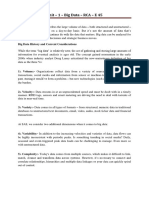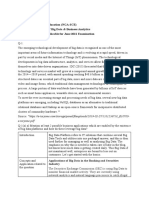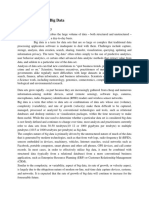0 ratings0% found this document useful (0 votes)
Big Data
Big Data
Uploaded by
Jose Antonio Velazquez GarciaThis document provides an overview of big data, defining it as large volumes of structured and unstructured data that are difficult to process using traditional databases and software. It discusses how big data can help companies make faster decisions and improve operations. Examples are given of the large sizes big data can be, such as petabytes or exabytes, and how it comes from various sources for billions of records on millions of people. The challenges of analyzing big data are described.
Copyright:
© All Rights Reserved
Available Formats
Download as PDF, TXT or read online from Scribd
Download as pdf or txt
Big Data
Big Data
Uploaded by
Jose Antonio Velazquez Garcia0 ratings0% found this document useful (0 votes)
This document provides an overview of big data, defining it as large volumes of structured and unstructured data that are difficult to process using traditional databases and software. It discusses how big data can help companies make faster decisions and improve operations. Examples are given of the large sizes big data can be, such as petabytes or exabytes, and how it comes from various sources for billions of records on millions of people. The challenges of analyzing big data are described.
Original Description:
grandes datos
Original Title
big data
Copyright
© © All Rights Reserved
Available Formats
PDF, TXT or read online from Scribd
Share this document
Did you find this document useful?
Is this content inappropriate?
This document provides an overview of big data, defining it as large volumes of structured and unstructured data that are difficult to process using traditional databases and software. It discusses how big data can help companies make faster decisions and improve operations. Examples are given of the large sizes big data can be, such as petabytes or exabytes, and how it comes from various sources for billions of records on millions of people. The challenges of analyzing big data are described.
Copyright:
© All Rights Reserved
Available Formats
Download as PDF, TXT or read online from Scribd
Download as pdf or txt
0 ratings0% found this document useful (0 votes)
Big Data
Big Data
Uploaded by
Jose Antonio Velazquez GarciaThis document provides an overview of big data, defining it as large volumes of structured and unstructured data that are difficult to process using traditional databases and software. It discusses how big data can help companies make faster decisions and improve operations. Examples are given of the large sizes big data can be, such as petabytes or exabytes, and how it comes from various sources for billions of records on millions of people. The challenges of analyzing big data are described.
Copyright:
© All Rights Reserved
Available Formats
Download as PDF, TXT or read online from Scribd
Download as pdf or txt
You are on page 1/ 9
Universidad Autonoma del Estado de Mexico
Centro Universitario Atlacomulco
Temas selectos de software
Jose Antonio Velazquez Garcia
Informatica Administrativa
LIA I-9
1/ Octubre / 2014
Big data
By Vangie Beal
Big data is a buzzword, or catch-phrase, used to describe a massive volume of
both structured and unstructured data that is so large that it's difficult to process
using traditional database and software techniques. In most enterprise scenarios
the data is too big or it moves too fast or it exceeds current processing capacity.
Big data has the potential to help companies improve operations and make faster,
more intelligent decisions.
Is Big Data a Volume or a Technology?
While the term may seem to reference the volume of data, that isn't always the
case. The term big data, especially when used by vendors, may refer to the
technology (which includes tools and processes) that an organization requires to
handle the large amounts of data and storage facilities. The term big data is
believed to have originated with Web search companies who needed to query very
large distributed aggregations of loosely-structured data.
An Example of Big Data
An example of big data might be petabytes (1,024 terabytes) or exabytes (1,024
petabytes) of data consisting of billions to trillions of records of millions of people
all from different sources (e.g. Web, sales, customer contact center, social media,
mobile data and so on). The data is typically loosely structured data that is often
incomplete and inaccessible.
Big Data and Types of Business Datasets
When dealing with larger datasets, organizations face difficulties in being able to
create, manipulate, and manage big data. Big data is particularly a problem in
business analytics because standard tools and procedures are not designed to
search and analyze massive datasets.
As research from Webopedia parent company QuinStreet demonstrates, big data
initiatives are poised for explosive growth. QuinStreet surveyed 540 enterprise
decision-makers involved in big data and found the datasets of interest to many
businesses today include traditional structured databases of inventories, orders,
and customer information, as well as unstructured data from the Web, social
networking sites, and intelligent devices.
This data, when captured, formatted, manipulated, stored, and analyzed can help a
company to gain useful insight to increase revenues, get or retain customers, and
improve operations. Big data may also be called enterprise big data.
Big data analytics
Big data analytics refers to the process of collecting, organizing and analyzing
large sets of data ("big data") to discover patterns and other useful information. Not
only will big data analytics help you to understand the information contained within
the data, but it will also help identify the data that is most important to the business
and future business decisions. Big data analysts basically want the knowledge that
comes from analyzing the data.
The Benefits of Big Data Analytics
Enterprises are increasingly looking to find actionable insights into their data. Many
big data projects originate from the need to answer specific business questions.
With the right big data analytics platforms in place, an enterprise can boost sales,
increase efficiency, and improve operations, customer service and risk
management.
Webopedia parent company, QuinStreet, surveyed 540 enterprise decision-makers
involved in big data purchases to learn which business areas companies plan to
use Big Data analytics to improve operations. About half of all respondents said
they were applying big data analytics to improve customer retention, help with
product development and gain a competitive advantage.
For most organizations, big data analysis is a challenge. Consider the sheer
volume of data and the many different formats of the data (both structured and
unstructured data) collected across the entire organization and the many different
ways different types of data can be combined, contrasted and analyzed to find
patterns and other useful information.
The first challenge is in breaking down data silos to access all data an organization
stores in different places and often in different systems. A second big data
challenge is in creating platforms that can pull in unstructured data as easily as
structured data. This massive volume of data is typically so large that it's difficult to
process using traditional database and software methods.
Big Data Requires High-Performance Analytics
To analyze such a large volume of data, big data analytics is typically performed
using specialized software tools and applications for predictive analytics, data
mining, text mining, forecasting and data optimization. Collectively these processes
are separate but highly integrated functions of high-performance analytics. Using
big data tools and software enables an organization to process extremely large
volumes of data that a business has collected to determine which data is relevant
and can be analyzed to drive better business decisions in the future.
Examples of How Big Data Analytics is Used Today
As technology to break down data silos and analyze data improves, business can
be transformed in all sorts of ways. According to Datamation, today's advances in
analyzing Big Data allow researchers to decode human DNA in minutes, predict
where terrorists plan to attack, determine which gene is mostly likely to be
responsible for certain diseases and, of course, which ads you are most likely to
respond to on Facebook. The business cases for leveraging Big Data are
compelling. For instance, Netflix mined its subscriber data to put the essential
ingredients together for its recent hit House of Cards, and subscriber data also
prompted the company to bring Arrested Development back from the dead.
Another example comes from one of the biggest mobile carriers in the world.
France's Orange launched its Data for Development project by releasing
subscriber data for customers in the Ivory Coast. The 2.5 billion records, which
were made anonymous, included details on calls and text messages exchanged
between 5 million users. Researchers accessed the data and sent Orange
proposals for how the data could serve as the foundation for development projects
to improve public health and safety. Proposed projects included one that showed
how to improve public safety by tracking cell phone data to map where people went
after emergencies; another showed how to use cellular data for disease
containment.
The pace of data creation will surely increase, especially as machine-to-machine
communications gets cheaper and more common. Think about how much data all
of those sensor networks, burglar alarms and vehicle telematics systems will
create.
According to IBM, every single day we create 2.5 quintillion bytes of data. IBM
argues that the exponential growth of data means that 90 percent of the data that
exists in the world today has been created in the last two years. "This data comes
from everywhere: sensors used to gather climate information, posts to social media
sites, digital pictures and videos, e-commerce transaction records, and cell phone
GPS coordinates, to name a few."
Of course, it's important to remember that in early human history, anything as
ephemeral as a tweet just would not have been recorded, so these comparisons
can only be taken so far.
To put the data explosion in context, consider this. Every minute of every day we
create
More than 204 million email messages
Over 2 million Google search queries
48 hours of new YouTube videos
684,000 bits of content shared on Facebook
More than 100,000 tweets
$272,000 spent on e-commerce
3,600 new photos shared on Instagram
Nearly 350 new WordPress blog posts
Big data
Por Vangie Beal
Big data es una palabra de moda, o coger-frase usada para describir un volumen
masivode datos tanto estructurados como no estructurados que es tan grande que
es difcil de procesar utilizandotcnicas de bases de datos y de software
tradicionales. En la mayora de escenarios empresariales los datos es
demasiadogrande o se mueve demasiado rpido o se excede la capacidad de
procesamiento actual. Grandes datos tiene el potencialpara ayudar a las empresas
a mejorar las operaciones y tomar decisiones ms rpidas, ms inteligentes. Es
grandede datos de un volumen o una tecnologa? Wi bien el trmino puede
parecer para hacer referencia al volumen odatos f,que no es siempre el caso. El
trmino grandes de datos, especialmente cuando se utilicen los proveedores,
pueden referirsea la tecnologa (que incluye herramientas y procesos) que una
organizacin requiere paramanejar las grandes cantidades deinstalaciones de
datos y almacenamiento. El trmino granSe cree que los datos que se
hanoriginado con las empresas de bsqueda Web que necesitaban consultar muy
grandes distribuidosagregaciones de datos estructurados dbilmente-. Un ejemplo
de Big Data Un ejemplo de datos grandespodra ser petabytes (1024 terabytes) o
exabytes (1.024 petabytes) de datos que constan demiles de millones a miles de
millones de registros de millones de personasde todo a partir de diferentes fuentes
(por ejemplo, Web, ventas, centro de contacto con el cliente, medios sociales,
mvilesde datos y as sucesivamente). Los datos son normalmente poco
estructurado de datos que a menudo es incompleta einaccesible. Datos y tipos de
conjuntos de datos de negocios cuando tratan con mayor grandeconjuntos de
datos,las organizaciones se enfrentan a dificultades en la capacidad de crear,
manipular y gestionar grandes volmenes de datos. Grandesdatos es un problema
particularmente en anlisis de negocios porque las herramientas estndar
yprocedimientosno estn diseados para buscar y analizar conjuntos de datos
masivos. Como la investigacin de Webopediamatriz QuinStreet demuestra,
iniciativas de grandes datos estn listos para explosivocrecimiento. QuinStreet
encuest a 540 empresas que toman las decisiones involucradas engrandes
volmenes de datos y encontrlos conjuntos de datos de inters para muchas
empresas hoy en da incluyen las bases de datos tradicionales estructuradosde
inventarios, pedidos y la informacin del cliente, as como datos no estructurados
de la Web,los sitios de redes sociales y dispositivos inteligentes. Estos datos,
cuando fue capturado, formateado,manipula, almacena, analiza y puede ayudar a
una empresa para obtener informacin til para incrementarlos ingresos, obtener o
retener a los clientes, y mejorar las operaciones. Grandes datos tambin pueden
ser llamadosde la empresa de datos grandes. Big Dataanaltica analtica de
grandes datos se refiere al proceso de recoleccin,organizacin y anlisis de
grandes conjuntos de datos ("big data") para descubrir patrones y otra
tilinformacin. No slo los grandes datosanalticas que ayudan a understand la
informacin contenidadentro de los datos, sino que tambin ayudar a identificar
los datossombrero es ms importante para el negocio y las decisiones futuras del
negocio. Los analistas de datos Bigbsicamente quieren que el conocimiento que
proviene de analizar ladatos. Los beneficios de Big Data Analytics Las empresas
estn cada vez
ms buscando para encontrar recurribles ideas en sus datos. Muchosproyectos de
grandes datos se originan en la necesidad de responder a las preguntas
especficas del negocio. Con lasgrandes plataformas de anlisis de los datos
correctos en el lugar, una empresa puede abuchearventas st, aumentar la
eficiencia,y mejorar las operaciones, servicio al cliente y la gestin de
riesgos. Padre Webopediaempresa, QuinStreet, encuest a 540 empresas que
toman las decisiones involucradas en big datacompras para saber qu reas de
negocio empresas planean utilizar anlisis de Big Data paramejorar las
operaciones. Aproximadamente la mitad de todos los encuestados dijeron que
estaban aplicando analtica de grandes datospara mejorar la retencin de clientes,
ayudar con el desarrollo de productos y ganar una competitivaventaja. Para la
mayora de las organizaciones, el anlisis de grandes datos es un reto. Considere
el enormevolumen de datos y los distintos formatos de los datos (estructurados y
no estructurados datos) recogido en toda la organizacin y las muchas maneras
en que diferentes tipos dedatos se pueden combinar, contrastados y analizados
para encontrar patrones y otra tilinformacin. El primer desafo es romper los
silos de datos para tener acceso a todos los datos de undepsitos de las
organizaciones en diferentes lugares y, a menudo en diferentes sistemas. Un
segundo de datos grandedesafo est en la creacin de plataformas que pueden
tirar en los datos no estructurados con tanta facilidad como estructuradosde
datos. Este volumen masivo de datos suele ser tan grande que es difcil de
procesar utilizandolos mtodos de base de datos y de software tradicionales. Big
DataRequiere Analytics de Alto RendimientoPara analizar un gran volumen de
datos como, anlisis de datos grandes se realiza normalmente
utilizandoherramientas de software y aplicaciones especializadas para el anlisis
predictivo, minera de datos, minera de texto,la prediccin y la optimizacin de
datos. En conjunto, estos procesos son distintos pero altamentefunciones
integradas de anlisis de alto rendimiento. El uso de herramientas de datos
grandes y softwarepermite a una organizacin para procesar extremadamente
grandes volmenes de datos que un negocio harecogido para determinar qu
datos son relevantes y pueden ser analizados para generar mejores
negociosdecisiones en el futuro. Ejemplos de cmo Big Data Analytics se utiliza
hoy como la tecnologapara romper los silos de datos y anlisis de datos mejora,
negocio puede transformarse en todaslas clases de maneras. Segn Datamation,
los avances en el anlisis de Big Data de hoy permitena los investigadores a
descifrar el ADN humano en cuestin de minutos, predicen que los terroristas
planean atacar,determinan qu gen es sobre todo probable queser responsables
de ciertas enfermedades y, por supuesto,que los anuncios que ms
estprobabilidades de responder a en Facebook. Los casos de negocio para
aprovecharlos grandes datos son convincentes. Por ejemplo, Netflix extrae sus
datos de suscriptor para poner los esencialesingredientes juntos por suxito
RECIENTES Castillo de naipes, y los datos de abonado tambin llev a la
compaa a llevar ArrestadoDesarrollo de entre los muertos. Otro ejemplo
proviene de uno de los mayores mvilestransportistas en el mundo. Orange de
Francia puso en marcha su proyecto de datos para el Desarrollo porla liberacin
de los datos de abonado para los clientes en la Costa de Marfil. Los 2,5 mil
millones de registros, quese realizaron en el anonimato, incluidos detalles sobre
las llamadas y text mensajes intercambiados entre 5millones de usuarios. Los
investigadores acceder a los datos y enviaron propuestas Orange de cmo los
datospueden servir de base para los proyectos de desarrollo para mejorar la salud
y la seguridad pblica.proyectos propuestos incluyen uno que mostraba la forma
de mejorar la seguridad pblica mediante el seguimiento de la clulapara mapear
los datos del telfono donde la gente iba despus de las emergencias ; otra
mostr cmo utilizarlos datos celulares para la contencin de la enfermedad. El
ritmo de creacin de datos seguramente aumentar,sobre todo porque las
comunicaciones de mquina a mquina se vuelve ms barato unnd ms
comn. Pienseacerca de la cantidad de datos todas esas redes de sensores,
alarmas antirrobo y de telemtica de vehculoslos sistemas va a crear. Segn IBM,
cada da creamos 2,5 trillones de bytes dedatos. IBM sostiene que el gro
exponencialwth de datos significa que el 90 por ciento de ldatos electrnicos
queexisten en el mundo de hoy se ha creado en los ltimos dos aos. "Estos datos
vienen detodas partes: sensores utilizados para recopilar informacin sobre el
clima, los mensajes a sitios de medios sociales, digitalesfotos y videos, registros
de transacciones de comercio electrnico, y las coordenadas de GPS del telfono
celular, paranombrar unos pocos. " Por supuesto, es importante recordar que a
principios dehistoria de la humanidad, algo tanefmero como un tweet simplemente
no se han registrado, por lo que estas comparaciones slo puedenser tomadas
hasta el momento. Para poner la explosin de datos en contexto, considere
esto. Cada minuto de cadada creamos ms de 204 millones de mensajes de
correo electrnico Ms de 2 millones Googleconsultas de bsquedade 48 horas de
nuevo los vdeos de YouTube 684.000 bits de contenido compartido en Facebook
ms de100.000 tweets de 272,000 dlares gastados en el comercio electrnico
3600 nuevas fotos compartidas en InstagramCasi 350 nuevo blog de
WordPressMensajes
MAPA CONCEPTUAL
Buscan encontrar
informacin procesable
-Softwares
-Aplicaciones
-redes sociales
-usos moviles
- determinar una decisin
-estructurados
- y no estructurados
-analiza y modifica
-lo utilizan las empresas
-pedidos, inventarios, informacin del cliente
-sitios de redes sociales y dispositivos inteligentes
You might also like
- Universidad Autonoma Del Estado de MexicoNo ratings yetUniversidad Autonoma Del Estado de Mexico7 pages
- Big Data: Management Information SystemsNo ratings yetBig Data: Management Information Systems11 pages
- Deloitte Solutions Network: Introduction To Big DataNo ratings yetDeloitte Solutions Network: Introduction To Big Data9 pages
- What is Big Data and Why is it Important_ _ Definition from TechTargetNo ratings yetWhat is Big Data and Why is it Important_ _ Definition from TechTarget15 pages
- Mittal School of Business: Course Code: CAP348 Course Title: Introduction To Big DataNo ratings yetMittal School of Business: Course Code: CAP348 Course Title: Introduction To Big Data6 pages
- Introductions: What Are The 5 Vs of Big Data/ Characteristics of Big Data or Nature of DataNo ratings yetIntroductions: What Are The 5 Vs of Big Data/ Characteristics of Big Data or Nature of Data75 pages
- Fundamentals of Big Data and Business Analytics - Assignment June 2021 K...No ratings yetFundamentals of Big Data and Business Analytics - Assignment June 2021 K...9 pages
- What Is Big Data & Why Is Big Data Important in Today's Era100% (1)What Is Big Data & Why Is Big Data Important in Today's Era13 pages
- Big Data Analytics: Recent Achievements and New ChallengesNo ratings yetBig Data Analytics: Recent Achievements and New Challenges5 pages
- Chapter 3 Big Data Analytics and Big Data Analytics Techniques PDFNo ratings yetChapter 3 Big Data Analytics and Big Data Analytics Techniques PDF22 pages
- Big Data: Opportunities and challengesFrom EverandBig Data: Opportunities and challengesBCS, The Chartered Institute for ITNo ratings yet
- Understanding Big Data: A Beginners Guide to Data Science & the Business ApplicationsFrom EverandUnderstanding Big Data: A Beginners Guide to Data Science & the Business Applications4/5 (5)
- Data-Driven Business Strategies: Understanding and Harnessing the Power of Big DataFrom EverandData-Driven Business Strategies: Understanding and Harnessing the Power of Big DataNo ratings yet
- Republic of The Philippines Department of Education: Grade SheetNo ratings yetRepublic of The Philippines Department of Education: Grade Sheet2 pages
- Searchq Proko+gesture&sca Esv A0e199fc98d1a06b&sca Upv 1&rlz 1C9BKJA enGT1089GT1089&hl Es&udm 2&biw 1080No ratings yetSearchq Proko+gesture&sca Esv A0e199fc98d1a06b&sca Upv 1&rlz 1C9BKJA enGT1089GT1089&hl Es&udm 2&biw 10801 page
- Attendance 11 Council Mass Demo Practice TemplateNo ratings yetAttendance 11 Council Mass Demo Practice Template2 pages
- Transformers: Windblade #4 (Of 4) : Dawn of The Autobots PreviewNo ratings yetTransformers: Windblade #4 (Of 4) : Dawn of The Autobots Preview7 pages
- Shaheedi Saake To Baad Da Itihaas (Bhag-1)No ratings yetShaheedi Saake To Baad Da Itihaas (Bhag-1)4 pages
- Lower Intermediate Lesson Plan (November)No ratings yetLower Intermediate Lesson Plan (November)2 pages
- modele-et-exemple-cahier-des-charges-community-managementNo ratings yetmodele-et-exemple-cahier-des-charges-community-management10 pages
- Data Analytics with Python: Data Analytics in Python Using PandasFrom EverandData Analytics with Python: Data Analytics in Python Using Pandas
- Deloitte Solutions Network: Introduction To Big DataDeloitte Solutions Network: Introduction To Big Data
- What is Big Data and Why is it Important_ _ Definition from TechTargetWhat is Big Data and Why is it Important_ _ Definition from TechTarget
- Mittal School of Business: Course Code: CAP348 Course Title: Introduction To Big DataMittal School of Business: Course Code: CAP348 Course Title: Introduction To Big Data
- Introductions: What Are The 5 Vs of Big Data/ Characteristics of Big Data or Nature of DataIntroductions: What Are The 5 Vs of Big Data/ Characteristics of Big Data or Nature of Data
- Fundamentals of Big Data and Business Analytics - Assignment June 2021 K...Fundamentals of Big Data and Business Analytics - Assignment June 2021 K...
- What Is Big Data & Why Is Big Data Important in Today's EraWhat Is Big Data & Why Is Big Data Important in Today's Era
- Big Data Analytics: Recent Achievements and New ChallengesBig Data Analytics: Recent Achievements and New Challenges
- Chapter 3 Big Data Analytics and Big Data Analytics Techniques PDFChapter 3 Big Data Analytics and Big Data Analytics Techniques PDF
- Understanding Big Data: A Beginners Guide to Data Science & the Business ApplicationsFrom EverandUnderstanding Big Data: A Beginners Guide to Data Science & the Business Applications
- Data-Driven Business Strategies: Understanding and Harnessing the Power of Big DataFrom EverandData-Driven Business Strategies: Understanding and Harnessing the Power of Big Data
- Republic of The Philippines Department of Education: Grade SheetRepublic of The Philippines Department of Education: Grade Sheet
- Searchq Proko+gesture&sca Esv A0e199fc98d1a06b&sca Upv 1&rlz 1C9BKJA enGT1089GT1089&hl Es&udm 2&biw 1080Searchq Proko+gesture&sca Esv A0e199fc98d1a06b&sca Upv 1&rlz 1C9BKJA enGT1089GT1089&hl Es&udm 2&biw 1080
- Transformers: Windblade #4 (Of 4) : Dawn of The Autobots PreviewTransformers: Windblade #4 (Of 4) : Dawn of The Autobots Preview
- modele-et-exemple-cahier-des-charges-community-managementmodele-et-exemple-cahier-des-charges-community-management

























































































